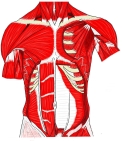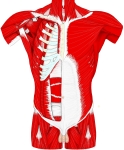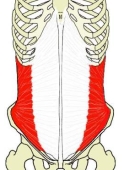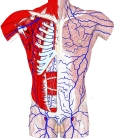内腹斜筋 ( ないふくしゃきん、 英 : internal oblique muscle )
・ 概 要 |
・ 作 用 |
・ イラスト掲載サイト |
|
・ イラスト |
・ 神経 / 脈管 |
||
・ 起始 / 停止 |
・ Wikipedia |
![]()


![]()
・ 筋繊維は外腹斜筋と交差するように走っている。
・「 外腹斜筋、内腹斜筋および腹横筋を合わせた筋腹の厚さは約2㎝であり、内腹斜筋が最も厚い。」 ( 骨格筋の形と触察法 ) 「 太峰閣 」P135
・「 少数の下部の筋束は挙睾筋 Mcremaster (Hodenheber) となって,精索あるいは子宮鼡径索とともに浅鼡径輪から外に現われている」(Rauber-Kopsch解剖学)

以下は 「船戸和也のHP」 の解説文の一部となる。
「この内腹斜筋の腱膜の線維は、白線において外腹斜筋の腱膜の線維と交織し、反対側の外腹斜筋の腱膜に連続する。こうして腹壁を斜めに取り巻く一続きの筋腱性の帯が形成され両側の2つの斜筋は1つの運動単位として結ばれることになる。内腹斜筋の筋線維束は、急角度で上昇し、筋性に第(9)10~12肋軟骨の下縁に停止する。これらの筋束は、頭側では明確な境界なしに内肋間筋に連続している。それより腹側で起こる内腹斜筋の筋線維束、腹側になればなるほど上に向かう角度がゆるやかになり、上前腸骨棘から起こる筋線維束はほぼ水平、鼡径靭帯から起こる筋線維束は斜め下方へ進むようになる。尾側部では、内腹斜筋を腹横筋から区別することが非常にむずかしい。2つの筋を頭側で隔てている結合組織層(その中を神経が走る)は、上前腸骨棘の高さで終わり、腸骨下腹神経の前皮枝と腸骨鼡径神経は、内腹斜筋の腹側面を走るようになる。」
また、「Rauber-Kopsch解剖学」 では以下のような解説が見られる。
「 変 異 : 肋骨における停止の数が普通より減少して2個になっていること,あるいは増加して4個になっていることがある.かなりしばしば腱画が最下部の肋骨の延長上にみられ,その中にはときに軟骨の含まれることがある.」
![]()
 |
 |
 |
|
![]()
【 起 始 】 : 鼡径靭帯、 腸骨の腸骨稜の中間線、 胸腰筋膜の深葉
【 停 止 】 : 第10から第12肋骨の下縁 ・腹直筋鞘 ・白線
![]()
・ 胸郭を引き下げる。 ・ 体幹を前屈、側屈、回旋させる。 ・ 骨盤を引き上げる。 ( 胸郭を固定したとき )
・「 腹部の圧縮、腹部の内臓を保護する、強い呼気の時活動する。」 ( 船戸和也のHP )
![]()
・ 神 経 : 肋間神経(T7からT12)、 腸骨下腹神経、 腸骨鼡径神経
・ 脈 管 : 上・下腹壁動脈 および 深腸骨回旋動脈 の筋枝 ( 船戸和也のHP )
The abdominal internal oblique muscle, also internal oblique muscle or interior oblique, is an abdominal muscle in the abdominal wall that lies below the external oblique muscle and just above the transverse abdominal muscle.
【 Structure 】
Its fibers run perpendicular to the external oblique muscle, beginning in the thoracolumbar fascia of the lower back, the anterior 2/3 of the iliac crest (upper part of hip bone) and the lateral half of the inguinal ligament. The muscle fibers run from these points superiomedially (up and towards midline) to the muscle's insertions on the inferior borders of the 10th through 12th ribs and the linea alba.
In males, the cremaster muscle is also attached to the internal oblique.
【 Nerve supply 】
The internal oblique is supplied by the lower intercostal nerves, as well as the iliohypogastric nerve and the ilioinguinal nerve.
【 Function 】
The internal oblique performs two major functions. Firstly as an accessory muscle of respiration, it acts as an antagonist (opponent) to the diaphragm, helping to reduce the volume of the chest cavity during exhalation. When the diaphragm contracts, it pulls the lower wall of the chest cavity down, increasing the volume of the lungs which then fill with air. Conversely, when the internal obliques contract they compress the organs of the abdomen, pushing them up into the diaphragm which intrudes back into the chest cavity reducing the volume of the air-filled lungs, producing an exhalation.
Secondly, its contraction causes ipsilateral rotation and side-bending. It acts with the external oblique muscle of the opposite side to achieve this torsional movement of the trunk. For example, the right internal oblique and the left external oblique contract as the torso flexes and rotates to bring the left shoulder towards the right hip. For this reason, the internal obliques are referred to as "same-side rotators."
【 語 句 】
・ abdominal wall : 腹壁 ・ external oblique muscle : 外腹斜筋 ・ transverse abdominal muscle : 腹横筋 ・ perpendicular : 垂直の ・ thoracolumbar fascia : 胸腰筋膜 ・ iliac crest : 腸骨稜 ・ inguinal ligament : 鼡径靭帯 ・ linea alba : 白線 ・ cremaster muscle : 精巣挙筋 ・ intercostal nerves : 肋間神経 ・ iliohypogastric nerve : 腸骨下腹神経 ・ ilioinguinal nerve : 長骨鼡径神経 ・ respiration : 呼吸 ・ antagonist : 拮抗筋 ・ diaphragm : 横隔膜 ・ chest cavity : 胸腔 ・ exhalation : 息を吐き出すこと ・ contract : 収縮する ・ intrude : 割り込む ・ipsilateral : 同側の ・ torsional : ねじれの ・ torso : 胴 ・ rotator : 回旋筋
![]()









